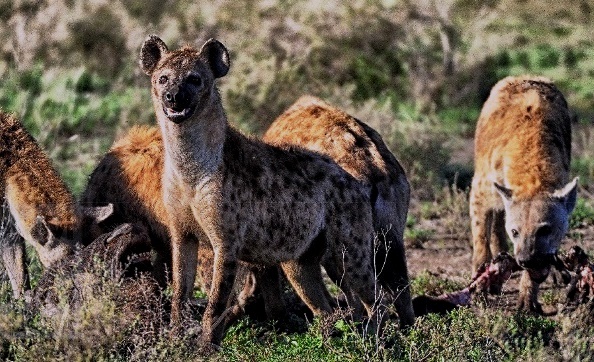The spotted hyena (Crocuta crocuta)—one of three species of hyenas found in Africa—is a highly social mammal that lives in large groups, or clans, containing at least 90 individuals. The social organization of spotted hyenas is more complex than the social structures found in many other carnivorous species and is dictated by specific matriarchal hierarchies because female spotted hyenas are dominant to their male counterparts. However, the exact manner by which hyenas establish and maintain their social hierarchies has been a mystery thus far. Now, data from an ongoing investigative project examining the social behavior of spotted hyenas for more than 27 years have enabled ethologists (researchers who study animal behavior) to conclude that hyena social hierarchies are formed by nongenetic networks of social inheritance in which young hyena cubs mimic their mother's behaviors. Social inheritance is the tendency for social affiliations of offspring to resemble those of their parents. See also: Ethology; Hyena; Social hierarchy; Social intelligence and the brain in the spotted hyena; Social mammals; Sociobiology

For many animal species, sociobiological structures are determined primarily by an animal's physical traits—for example, size and strength—which have genetic origins. The social networks of spotted hyenas, though, are imprinted and ultimately inherited from hyena mothers to their cubs via processes that have evolved to maintain social rank and affiliative interactions—that is, friendly and peaceful interactions among individuals of a species. The social inheritance of status and affiliative behaviors is particularly important because these inherited features have been shown to correlate with overall hyena survival and reproductive success. In other words, a young hyena's ability to maintain social structure and social bonds with both its mother and its mother's associates in the clan improves that cub's health and longevity. Furthermore, affiliative interactions and social networks are preserved by hyena offspring as they age, and this preservation holds true for cases in which the mother hyena has died or the cub no longer spends much time in proximity with its mother. (Typically, young hyenas remain close to their mothers for the first two years of life.) See also: Behavior genetics; Behavioral ecology; Genetics; Reproductive behavior
The inheritance of social networks among hyenas also occurs most strongly for offspring of the highest-ranking mothers. Specifically, hyena mothers with the highest social status in their clan societies have offspring that more accurately replicate their mother's interactions with other clan members as compared to offspring of hyena mothers of a lower social rank. The inheritance of social networks also helps to ensure the continuance of the clan's overall structural stability and allows for the social organization of the hyena clan to remain in place through succeeding generations. The study of social inheritance in spotted hyenas thus highlights that nongenetic factors play significant roles in evolutionary outcomes, particularly with regard to survival of the fittest. Ethologists hope that conclusions drawn from studies of hyena social structure can be applied to a wide range of other social mammals, including elephants, monkeys, and dolphins. See also: Animal evolution; Evolution





